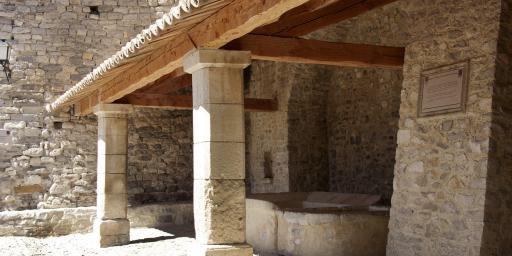Airing Your Dirty Laundry, the Lavoirs of Provence the Place for Washing and Gossip
Kneeling on a garde genoux (wooden knee protector) by the edge of the public wash basin, local peasant-class women exchanged tidbits of town gossip as they worked tirelessly to brighten their laundry. Their weathered hands vigorously scrubbed away at stubborn stains as water sloshed against the shallow stone sides of the village lavoir in Provence.
Before communal lavoirs, personal washing was done sparingly by the side of rivers or using precious well water. The washerwoman was often the lady of the house, or in instances of greater wealth, this was an outsourced activity. Laundry was done sparingly, often collected for many months in humidity-free attics or armoires.
This strenuous task was limited to a few times a year when the town’s washing was done over a three-day period a tradition called “la grande buée” or “la grande lessive” (the big wash).
Three Days of Washing
Purgatory (Purgatoire) involved a full day of soaking. This was to start loosening stains from the clothes, linens, drapes, blankets, tablecloths and other laundry.
Hell (Enfer) was the day when laundry was placed in a wooden barrel (called a buerie) and layered with whitening agents such eggshells, lavender, locally collected natural herbs, clover (to ward off moths) and fresh ash (for cleansing). Boiling water was poured over the top and allowed to drain out of a hole in the bottom, and the process repeated several times.
Heaven (Paradis) involved a full day of rinsing. The heavy wet loads were taken by cart or wheelbarrow to the central lavoir. This day for the ladies was extremely physical; they would kneel on wooden boxes or buckets (called carrosses or augets) with only a bit of cushioning as they beat and scrubbed the laundry to remove any accumulated soap and ash.
Finally, the clean clothes and linens would be hung under the roof of the lavoir or on nearby bushes to dry. Any bliss found on this final day was in the social gathering of women sharing a common task and in the knowledge that the chore was done.
A Construction Project
By the end of the 18th century, construction of these public basins became more common as a way to avoid the spread of deadly diseases such as cholera and typhoid. On February 3, 1851, a law was passed under Napoleon III permitting State subsidies of up to 30% of the construction costs for these facilities.
Typical construction of a lavoir included a stone basin with drainage and flowing water and a roof, to provide shade and protection from the elements.
With the benefit of funding, the number of lavoirs in Provence (and the rest of France) increased dramatically and so did the frequency of washing. Similar to local village clock towers, the architectural extravagance of a lavoir became a status symbol for the community.
Eventually, with the modern-day benefits of tap water and washing machines eliminated the activity and daily conversation at the lavoirs. The buildings fell into disrepair, and many were destroyed. More recently there has been recognition of the unique historical significance and architectural beauty of some of these lavoirs and even an association (here is the website), which maintains a list.
Visit a lavoir in Provence, and you can almost hear the local gossip flowing.
You can read the original post Ginger and Nutmeg here.




No Comment